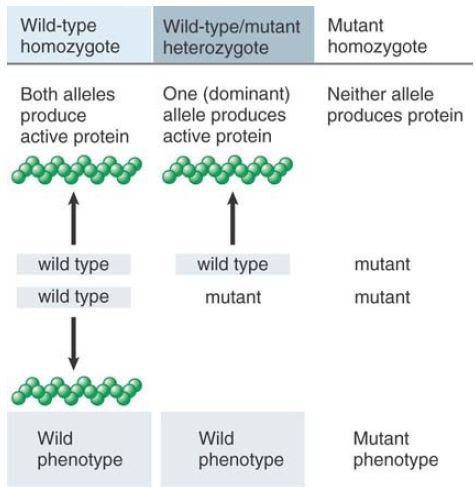
Most Genes Encode Polypeptides
 المؤلف:
JOCELYN E. KREBS, ELLIOTT S. GOLDSTEIN and STEPHEN T. KILPATRICK
المؤلف:
JOCELYN E. KREBS, ELLIOTT S. GOLDSTEIN and STEPHEN T. KILPATRICK
 المصدر:
LEWIN’S GENES XII
المصدر:
LEWIN’S GENES XII
 الجزء والصفحة:
الجزء والصفحة:
 27-2-2021
27-2-2021
 2368
2368
Most Genes Encode Polypeptides
KEY CONCEPTS
-The one gene–one enzyme hypothesis summarizes the basis of modern genetics: that a typical gene is a stretch of DNA encoding one or more isoforms of a single polypeptide chain.
-Some genes do not encode polypeptides, but encode structural or regulatory RNAs.
-Many mutations in coding sequences damage gene function and are recessive to the wild-type allele.
The first systematic attempt to associate genes with enzymes, carried out by Beadle and Tatum in the 1940s, showed that each stage in a metabolic pathway is catalyzed by a single enzyme and can be blocked by mutation in a single gene. This led to the one gene–one enzyme hypothesis. A mutation in a gene alters the activity of the protein enzyme it encodes.
A modification in the hypothesis is needed to apply to proteins that consist of more than one polypeptide subunit. If the subunits are all the same, the protein is a homomultimer and is encoded by a single gene. If the subunits are different, the protein is a heteromultimer, and each different subunit can be encoded by a different gene. Stated as a more general rule applicable to any heteromultimeric protein, the one gene–one enzyme hypothesis becomes more precisely expressed as the one gene–one polypeptide hypothesis. (Even this modification is not completely descriptive of the relationship between genes and proteins, because many genes encode alternate versions of a polypeptide; this concept can be explored further under the topic of alternative splicing in multicellular eukaryotes in the chapter titled RNA Splicing and Processing.)
Identifying the biochemical effects of a particular mutation can be a protracted task. The mutation responsible for Mendel’s wrinkledpea phenotype was identified only in 1990 as an alteration that inactivates the gene for a starch-debranching enzyme!
It is important to remember that a gene does not directly generate a polypeptide: A gene encodes an RNA, which can in turn encode a polypeptide. Most genes are structural genes that encode messenger RNAs, which in turn direct the synthesis of polypeptides, but some genes encode RNAs that are not translated to polypeptides. These RNAs might be structural components of the protein synthesis machinery or might have roles in regulating gene expression (see the chapter titled Regulatory RNA). The basic principle is that the gene is a sequence of DNA that specifies the sequence of an independent product. The process of gene
expression might terminate in a product that is either RNA or polypeptide.
A mutation in a coding region is generally a random event with regard to the structure and function of the gene; mutations can have little or no effect (as in the case of neutral mutations), or they can damage or even abolish gene function. Most mutations that affect gene function are recessive: They result in an absence of function, because the mutant gene does not produce its usual polypeptide. FIGURE 1.33 illustrates the relationship between mutant recessive and wild-type alleles. When a heterozygote contains one wild-type allele and one mutant allele, the wild-type allele is able to direct production of the enzyme and is therefore dominant. (This assumes that an adequate amount of product is made by the single wild-type allele. When this is not true, the smaller amount made by one allele as compared to two alleles results in the intermediate phenotype of a partially dominant allele in a heterozygote.)

FIGURE 1. Genes encode proteins; dominance is explained by the properties of mutant proteins. A recessive allele does not contribute to the phenotype because it produces no protein (or protein that is nonfunctional).
 الاكثر قراءة في مواضيع عامة في الاحياء الجزيئي
الاكثر قراءة في مواضيع عامة في الاحياء الجزيئي
 اخر الاخبار
اخر الاخبار
اخبار العتبة العباسية المقدسة


